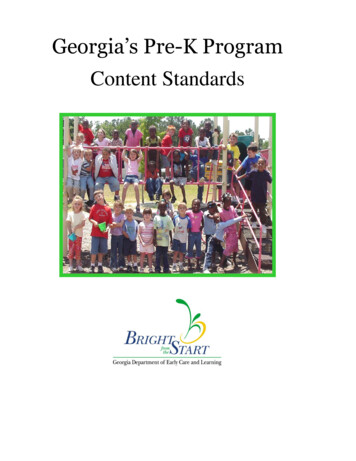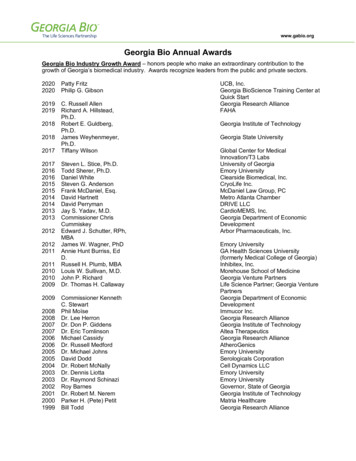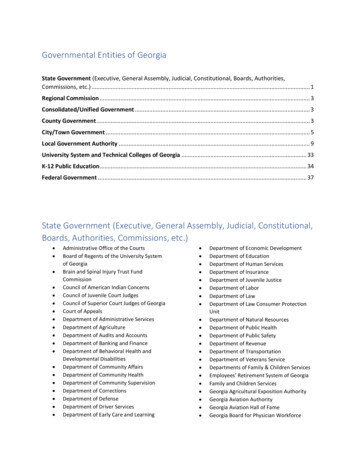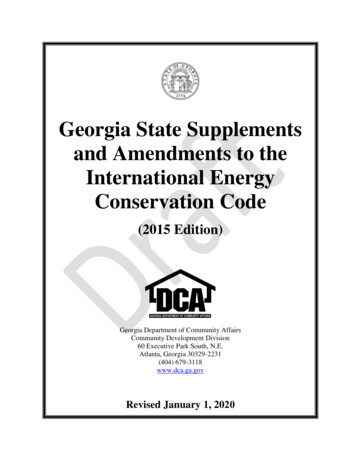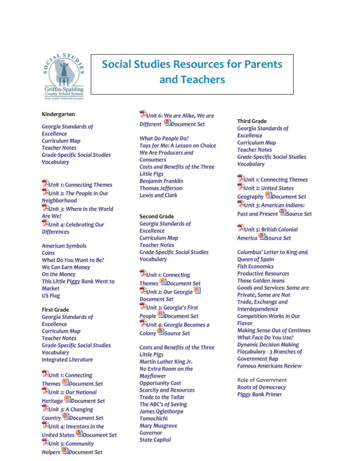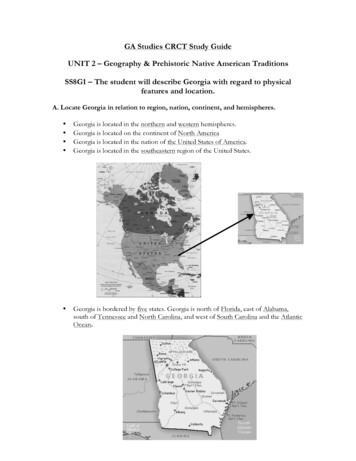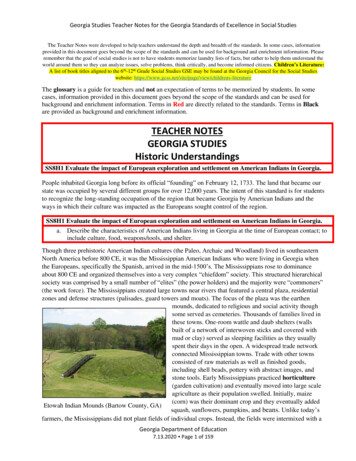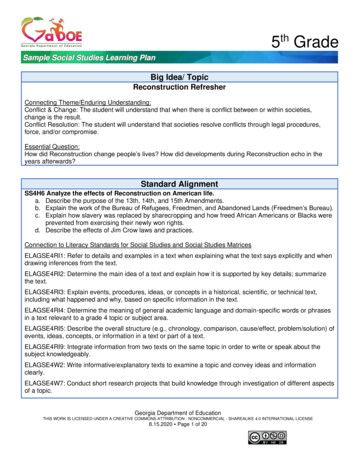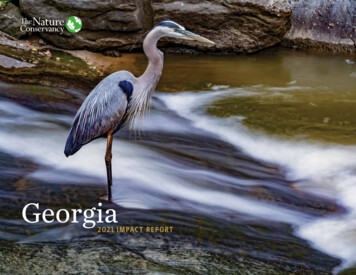
Transcription
Georgia2 0 2 1 I M PA C T R E P O R T
FROM THE DIRECTOR2030 GOALSThe Nature Conservancyin GeorgiaTaking Action For NatureFY21 Board of TrusteesChair: Mary Beth JordanYolanda AdreanBryan BatsonNina ButlerMarsha CertainRevonda CosbyJohn D’AndreaDane DickieLinda DiSantisCarolyn GibbsBailey IzardBen JordanMason Hardaway LamptonNancy Clair McInaneyScott SatterwhiteRaymond SingletaryChris WeberJeannie WrightThe last year challengedus all to reevaluate ourpriorities and find new waysof getting things done. That’scertainly true for The NatureConservancy in Georgia,and I’m amazed at what ourteams and partnershipshave accomplished. Through the creativity of ourscience-driven staff working in communities from northto south, the people and nature of Georgia are enjoyingthe benefits of our commitment to conservation.We enhanced the sustainability of our 35,000 acreChattahoochee Fall Line program near Columbus, alandscape of native wildlife and plant communities.We expanded the 18,000-acre Broxton RocksConservation Area in Coffee County with thepurchase of 1,000 acres that feature a high diversityof plants and provide habitat for a variety of animalspecies. One generous donor provided full projectfunding, including stewardship funds that will provideopportunities for fire crews, interns and others totrain, work on, study and learn from this property.TNC has made it a goal to conserve and restore longleafpine forests across the Southeast, with longleaf pinemanagement being a key part of forest programs in ninestates. In Georgia, we planted 683,860 longleaf pinetrees, and because fire is a natural part of the longleaflandscape, we burned a record number of acres: 58,269.Thanks to our work co-managing the longleaf pine forestsof the Moody Forest Nature Preserve in Appling Countythis year, our experts observed 17 fledgling red-cockadedwoodpeckers at this location.These are just a few examples of our impact in Georgiawith support from partner organizations and our generousdonor community. Taking actions like these in this decadewill define our state’s and the planet’s path over the nextcentury. We are taking on the dual threats of acceleratedclimate change and unprecedented biodiversity loss whilemaximizing resilience and benefits for our most preciousecosystems and vulnerable communities. By letting science guide our focus and equity guide our execution, wecan shape a better future for people and our planet.Deron DavisExecutive Director, The Nature Conservancy in GeorgiaYOUR SUPPORTThe Decade To Deliver Our GoalsWe are facing the biggest, most complex environmental challenges of our lives. Our planet is threatened bythe dual crises of rapid climate change and biodiversity loss—and addressing both is crucial. That’s why TNCas a whole, and our partners, are committed to pursuing bold solutions that will benefit biodiversity, sequestercarbon and reduce risk to the people and places most vulnerable to the impacts of climate change.WHY NOW?By 2030, our aim is to maximize nature’s ability tofight climate change while bolstering resilience for ourmost precious ecosystems and vulnerable communities.TNC invites you to join us in realizing these ambitiousglobal goals for 2030:Climate Remove or sequester 3 billion metricThree quarters of the carbondioxide emissions driven by humans hasoccurred since 1950.There has been nearly a70% averagedecline of birds, fishamphibians, mammalsand reptiles since 1970.We have years,not decades,to address theseexistential threats.tons of carbon dioxide emissions per year—the same asremoving 650 million cars off the road—and help 100 millionpeople who are most likely to be affected by climate-relatedemergencies such as floods, fires and droughtOcean Conserve nearly 10 billion acres ofocean—more than 10 percent of the world’s ocean areaLands Conserve over 1.5 billion acres of healthylands, such as forests and grasslands—an area twicethe size of IndiaFreshwaterConserve over 620,000 miles ofriver systems and 74 million acres of lakes andwetlands—enough river length to circumnavigate theglobe 25 timesHow your support forTNC Georgia makesa global impactIn Georgia, TNC contributesto global conservations goalsthrough four strategic prioritiesand a suite of strategies thatwork together to help us pursueour vision for a world wherenature and people thrive:Protect Oceans,Lands & WatersSustainably managingour coast and ocean forpeople and nature, conservingGeorgia’s critical landscapesand securing the health ofGeorgia’s rivers and streamsTackle Climate ChangeAccelerating solutions in thisdetermining decadeBuild Healthy CitiesIncreasing greenspace andequity in Atlanta’s SouthRiver WatershedStrengthen Our OrganizationCreating a lasting foundationfor the futurePeople Support 45 million people who depend on theocean, freshwater and lands for their wellbeing and livelihoods2 Impact Report 2021Cover Blue Heron John Roling/TNC Photo Contest 2019; this page Gopher Tortoise Marc Del Santro; Deron Davis Eliot VanOtterennature.org/georgia 3
For the Love of GeorgiaLANDProtecting our state’s most precious placesThe Carter tractincludes land witha high diversity ofplants and provideshabitat for keyanimal species.Expansion of Broxton RocksGenerous gifts from our partners and donors in 2021helped us conserve more of our state’s treasuredlands. A 2 million gift resulted in the addition of the1,114-acre Carter tract to the existing 18,000 acres ofprotected lands in the Broxton Rocks ConservationArea in southeast Georgia.Broxton Rocks is one of our state’s most scenicconservation sites and features a waterfall cascadingover rock ledges, 30-foot-high cliffs, cave-like crevicesand almost desert-like conditions on the flat rocksabove the fissures. These unique elements make itboth a sought-after place for visitors to experienceand home to a variety of plant and animal species.The Carter tract includes land with a high diversityof plants and provides habitat for key animal specieslike the federally threatened eastern indigo snake,the eastern diamondback rattlesnake and the gophertortoise. The existing tortoises found on the tractcomplete one additional protected population to thestate’s goal of protecting 65 viable populations.The land is protected and managed by the collectiveefforts of TNC, local landowners, Coffee County, theGeorgia Department of Natural Resources, GeorgiaForestry Commission and other partners. Managementat Broxton Rocks includes controlled burns that areessential for maintaining natural plant and animalcommunities. We also plant longleaf pines, wiregrassand other native species to restore natural diversity,and remove non-native, invasive species where needed.More Conservation Wins for GeorgiaFledgling Progress at Moody ForestIn 2001, TNC entered into a groundbreakingpublic/private land management partnership withthe Georgia Department of Natural Resources tocreate and manage the Moody Forest Preserve insoutheast Georgia. This collaborative effort hasgreatly improved the quality of forest habitat, restorednative plant and animal communities and increasedthe overall diversity of life found on the preserve.One species making a comeback here is the federallyendangered red-cockaded woodpecker.ONLINE I Learn more about our work go to nature.org/georgia4 Impact Report 2021this page Carnivorous pitcher plant Rich Reid opposite page Longleaf pine forest Rich Reid inset left to right Gopher Tortoise Marc Del Santro;Eastern indigo snake Dirk J. Stevenson; Red-cockaded woodpecker in flight Ralph Pacenature.org/georgia 5
“They need live pine trees that are old and infected withred heart fungus to make excavating easier,” says ChuckMartin, the director of Moody Forest Preserve. Over time,the mature pine forests where these birds thrive havedecreased from 90 million to 5 million acres.Protecting the Chattahoochee Fall LineWe received a 7.5 million dollar commitment from theU.S. Army to continue management of our ChattahoocheeFall Line program near Columbus. This funding will helpTNC enhance sustainability on 35,000 acres of nativewildlife and plant communities that support forestry,farming, outdoor recreation, tourism and the militarytraining mission at Fort Benning.INTERNSHIP58,269TOTAL ACRESBURNED BY TNCFIRE CREWS9,90468 TNC burn assists in GeorgiaACRESACRES25,319 23,04618 TNC burn assist inAlabama, Florida andSouth CarolinaNoah HowieInternship SparksOpportunityThrough an internship with TNC, BerryCollege environmental science majorNoah Howie assisted TNC Georgia withprescribed burns and has received agraduate teaching assistantship in theForest Dynamics Lab at the Universityof Alabama.ACRESWhen TNC and the Georgia Department of NaturalResources purchased the first 3,500 acres at MoodyForest, the local population of red-cockaded woodpeckershad dwindled to just a single pair. This year, TNC expertscounted a total of 17 chicks from 6 different breeding pairsthat had naturally traveled to or were successfully relocatedto the preserve. That’s fledgling progress to celebrate!PRESCRIBED BURNS THIS YEAR43 TNC-led burns in GeorgiaFort Benning is home to some of Georgia’s best remainingstands of the rare longleaf pine forest, making it an islandof vital habitat for the red-cockaded woodpecker andour state reptile—the gopher tortoise. Thanks to thisgenerous investment from the U.S. Army, we will be ableto continue establishing a conservation corridor for theseendemic species.Land Management UpdateThe Georgia land management team had an exceptionalyear, planting 683,860 trees and applying prescribed fireto more than 58,000 acres across four states.Red-cockaded Woodpecker Carlton Ward Jr. inset top to bottom Chattahoochee Fall Line in Georgia Erika Nortemann/TNC; Regenerationof longleaf pine forest Mark Godfrey/TNC; A prescribed burn in Moody Forest Natural Area Rich Reid this page left to right Member of TNC’s firecrew conducts a prescribed burn at Fort Benning in Georgia Erika Nortemann/TNC; Noah Howie and Dr. Zachary Taylor conduct research in the woodsof Berry’s mountain campus. Berry College 2021opposite page6 Impact Report 2021nature.org/georgia 7
Clearing the Way ForHealthier FishFRESHWATERThis year, TNCGeorgia completeda fish passageproject in MurrayCounty, GeorgiaIn order to address declining populations of nativemussels and fish in the Upper Coosa River Basin,we engaged in two important projects within theConasauga watershed—propagating Alabamarainbow (Villosa nebulosa) mussels for reintroductioninto the Holly Creek watershed and conducting acomprehensive barrier assessment of road crossingsover streams for adequate fish passage.There are more than 200 road crossings over streamsin the Holly Creek watershed in northwest Georgia,some of which allow fish passage during a varietyof flow conditions. However, many are barriers topassage, especially to small-bodied fish. Replacingthese barriers with structures designed to optimizefish passage can result in habitat improvement,increased populations of target species and greaterresilience of these populations.This year, TNC Georgia completed a fish passageproject in Murray County, Georgia on a tributary ofRock Creek within the larger Conasauga watershed.We also worked with the Georgia Department ofNatural Resources to successfully propagate severalthousand juvenile Alabama rainbow mussels forreintroduction into Holly Creek. Propagation for asecond mussel species, the Coosa creekshell (Villosaumbrans), will take place in 2022 and introductionto the watershed is planned for 2023.ONLINE I Learn more about Georgia’s freshwater projects at nature.org/georgiaKatie Owens, GA’s Upper Coosa Program Director, working on a mussel reintroduction project in Holly Creek Katie Owens/TNC. Handful of Alabama rainbow mussel Katie Owens/TNC; opposite page Crew working to reintroduce and augment mussel populations in the Upper Coosa River Katie Owens/TNC; inset left to right Upper Coosa River Katie Owens/TNC; Largemouth bass iStock; Autumn in the Holly Creek Preserve in Georgia. Katherine ThomasPhotographyleft to right8 Impact Report 2021nature.org/georgia 9
Protecting CoastalCommunitiesCOASTMore than a thirdof Camden Countyresidents live withinthe 100-year floodplain,and half of the land isclassified as wetlands.Innovating for People and NatureGeorgia’s low-lying coastal communities face increasingrisks to human safety, wildlife habitat and economicstability from flooding caused by sea level rise, stormsurge and other impacts of climate change. More thana third of Camden County residents live within the100-year floodplain, and half of the land is classifiedas wetlands. We are working in partnership withCamden County and others to create the county’s“Rise Ready” coastal resilience toolkit.This year, a new Flood Awareness Tool, the FloodRisk App, was made available to help planningofficials and future residents of Camden Countymake informed decisions to prepare for floodingand reduce its impact. The app allows users to searchaddresses in the county and integrates flood hazarddata to generate a personalized impact of currentand future potential flood risks. This is one exampleof how TNC is innovating to protect communitiesfrom the threats of climate change.Land Acquisitions Protect KeyCoastal LandscapeOn February 25, 2021, the 11,000-acre Cabin Blufftract—the last large, undeveloped portion ofGeorgia’s coast—became permanently protected.We closed on the sale of 8,000 acres of Cabin Bluffto the State of Georgia for designation as a newwildlife management area. TNC facilitated thesale of the remaining 3,000 acres of the historicproperty in Camden County to the Church ofEleven22, a congregation committed to thelong-term preservation of the land.This milestone comes more than two years afterTNC and the Open Space Institute purchasedthe property. Several government agencies andnonprofit partners aided in the protection of thispriority landscape, with more than 2.5 milliongranted through the first round of Georgia OutdoorStewardship Act funding, a program Georgia votersapproved with 83 percent support on the 2018statewide ballot.ONLINE I Learn more about Georgia’s coastal projects at nature.org/georgia10 Impact Report 2021Flooding at Saint Simon’s Island iStock opposite page Coastal pine forest at Cabin Bluff Mac Stone.jpg inset top to bottom Pelicans on the Georgiacoast Ron Goldfarb; Oak hammock trail at Cabin Bluff Mac Stone; Oystercatcher looking for their preferred food Ron Goldfarbthis pageWith support from TNC, the OpenSpace Institute and The ConservationFund acquired the neighboring16,000-acre Ceylon property in May.Thanks to the efforts of a visionarygroup of conservation leaders, morethan 27,000 new acres serving as acrucial buffer to the Naval SubmarineBase Kings Bay and the CumberlandIsland National Seashore are nowpermanently protected, with thousandsof acres publicly accessible.“These collaborations give the peopleof our state beautiful natural areas toexplore, provide vital habitat for plantsand animals, help clean our air andwater and buffer communities fromstorm surges,” said TNC GeorgiaExecutive Director Deron Davis.An ancestral home of the Yamassee,Timucua and Muscogee/Creek people,the landscape is a highly diverse mixof salt marshes, tidal creeks, maritimeforests and longleaf pine woodlands.It supports many threatened andendangered species, including themanatee, gopher tortoise, wood storkand eastern indigo snake.We are grateful to all partners on thisproject, which will continue to protecthabitat for critical species in our state.nature.org/georgia 11
CITIESCLIMATEAtlanta’s SouthRiver ForestGains GroundLast year, we championed The Conservation Fund’s purchase of morethan 200 acres of forest known as Lake Charlotte Nature Preserve insoutheast Atlanta, and now the City has officially purchased the tract,permanently protecting the property from development.The protection of Lake Charlotte is one part of a very big vision thatTNC Georgia is working with many partners to bring to fruition. We arefollowing a 20-year plan for the area that was inspired by the Atlanta CityDesign, which includes a massive public greenspace within the SouthRiver watershed. Since 2018, we have been working with renowned urbanplanner, Ryan Gravel, and other community leaders to build momentumaround this vision. In 2022, we will partner with the Atlanta RegionalCommission, the City of Atlanta, DeKalb County and communitymembers to expand community engagement and local governmentcommitment to the South River Forest.Now more than ever, we understand that greenspace is a vitalcomponent of a healthy, equitable, resilient and thriving city.As Atlanta’s growth continues, greenspace will be necessary tomaintain and enhance quality of life for all people.12 Impact Report 2021Clean trail at South River Forest John Amis inset top to bottom Clean up underway at South River Forest John Amis; Viewfrom boardwalk at South River Forest John AmisClean Energy,Minimal ImpactGeorgia’s landscape and plentiful sunshine make our state perfect forproviding homegrown solar energy. But the panels that generate thispower require a lot of space. Solar facilities in Georgia typically rangefrom 15 to 50 acres, and the conversion of this land to solar generationcould exact a heavy toll on environmentally sensitive habitat—and thewildlife, plants and people who depend on it.In partnership with the Georgia Department of Natural Resources, theUniversity of Georgia and NASA DEVELOP, TNC Georgia has developed amapping tool that helps developers identify potential solar energy generationsites that pose minimal impact to sensitive lands and critical habitat.The Low Impact Solar Siting Tool identifies solar suitability factors suchas land slope, solar radiation capacity and proximity to transmission lines.It also enables users to see where sensitive ecosystem areas are located,including those for threatened species like the gopher tortoise. By givingusers the ability to see which areas in the state provide both good solarsuitability and low impact on sensitive habitats, the tool can help developersbring facilities to operation quicker and more cost effectively.This is just one example of how we are working to expedite the smart growthof solar energy in our state. Shifting from fossil fuels to clean renewableenergy like solar is essential to achieving the low-carbon future we need tocombat climate change. We are proud to help advance solutions like the LowImpact Solar Siting Tool to help secure a clean energy future for Georgia. Dave Lauridseninset top to bottom Matt Kane/TNC; Dave Lauridsennature.org/georgia 13
Less CO2, More H2OPOLICYThis legislationcreates a dualpathway forbusinesses to accruecarbon credits andaims to increase theuse of constructionmaterials thatsequester carbonGeorgia Establishes SustainableDevelopment Carbon RegistryIn May, Governor Brian Kemp signed House Bill 355(HB* 355) into law. A measure with strong supportfrom TNC, this bill expands Georgia’s existing CarbonSequestration Registry, allows building materialsthat sequester (or store) carbon to qualify for carboncredits and adds stands of timber to the list of itemsthat qualify for credits.HB 355 established the Sustainable Development CarbonRegistry by expanding Georgia’s existing carbon registryto enable the creation and tracking of carbon creditsthat are tied to carbon sequestered in constructionprojects throughout the state as well as the embodiedcarbon benefits arising from a whole-building life cycleassessment. This legislation creates a dual pathway forbusinesses to accrue carbon credits and aims to increasethe use of construction materials that sequester carbon,furthering sustainable development in Georgia.Under the new law, developers will be able to gaincarbon credits by utilizing materials and technologythat increase the amount of CO₂ sequestered in theirbuildings, such as CO₂ infused concrete, mass timber andcarbon neutral flooring. The result is a non-regulatory,voluntary and incentive-based system that encouragessustainable development in Georgia and allows our stateto benefit from the increasing number of businesseslooking to offset their carbon footprint.GA-FIT: A New Partnership forDrought ResponseIn southwest Georgia, water is the lifeblood thatsustains aquatic ecosystems and a robust agriculturaleconomy. Water from the region’s rivers and aquifers isabundant in most years, but in others, drought makeswater scarce and threatens the viability of the localeconomy and aquatic habitats.With our support, the region’s farmers use watercarefully and have adopted efficient irrigationequipment and practices, yet even with widespreadapplication of water conservation measures, in-streamflows have set record lows in recent droughts. Flowsin the Ichawaynochaway Creek Basin, which supportONLINE I Learn more about Georgia’s sustainable projects at nature.org/georgia14 Impact Report 2021Georgia state capital building Dave5957/iStock opposite page Watering system Gaston Lacombe inset left to right A pivot irrigation system whichwill be adapted to a variable rate system for the purpose of water conservation Mark Godfrey/TNC; Mark Godfrey/TNC; Erika Nortemann/TNCthis pagemany streams and aquifers in the area,have decreased to lower levels overtime (with flows close to zero duringthe drought of 2011-2012), threateningthe availability of water for aquatichabitat and for use by farmers andcommunities downstream.Research funded by TNC indicatesthat relatively modest reductions inirrigation-water use during times ofdrought would result in ecologicallysignificant increases in stream flow. Inpartnership with the Georgia WaterPlanning & Policy Center at AlbanyState University, TNC has developed theGeorgia Flow Incentive Trust (GA-FIT)—aproject aimed at exploring opportunitiesfor innovative water managementstrategies in southwest Georgia.Funded by a grant from the RobertW. Woodruff Foundation, GA-FIT isworking with farmers to develop newdrought response tools and policies foragriculture. This pilot project will testcarefully designed incentives that cansustain farmers while also maintaininghealthy aquatic habitats during drought.GA-FIT activities will be focused primarilyin the Ichawaynochaway Creek Basin,but project findings will help inform ourwork throughout Georgia and beyond.nature.org/georgia 15
COLLABORATIONWe’re exploringthe positive impactconservationcan have on ruralcommunities.People and NatureThriving TogetherUGA Joins TNC to Support Community,Conservation at Fort BenningThe University of Georgia Carl Vinson Institute ofGovernment has joined the River Valley RegionalCommission and TNC to create recreation andeconomic opportunities along 35,000 acres ofconservation lands around Fort Benning. Spreadacross six midwestern Georgia counties and onecounty in Alabama, this land serves as the ArmyCompatible Use Buffer (ACUB) for Fort Benning,providing the base with a natural barrier to preventtraining and testing from interfering with thesurrounding communities and maximizing thebenefits to people and nature.The goal of the collaborative partnership is towork with nearby communities to develop a cohesiveplan to grow, promote and better utilize outdooractivities in the region, such as hiking, rafting andhunting. In addition to recreational and economicdevelopment, conservation of the land will continueto be guided by TNC.“This is a unique part of the state because it’s on theChattahoochee Fall Line,” noted Deron Davis, theexecutive director of TNC Georgia and chair of theACUB advisory board. “What you find is reallycomplicated soil structure. You find soils that looklike the beach, but you also find soils that look like thePiedmont or in some rare cases the mountain. Whatthe soil looks like dictates what the plants look like,and what the plants look like dictates what the animalslook like. So by having a relatively tight geographicregion with a mix of soils so close together gives youthings that are almost anomalous. The complexityand the variety is what makes this area unique.”We have been Fort Benning’s ACUB partner since 2007.While the U.S. Army’s needs require that the bufferland remains undeveloped, it can still provide outdoorrecreation opportunities for local communities and theeconomic industries that accompany them. As this planprogresses, TNC Georgia will help ensure that protectedACUB lands continue to provide a safe habitat for thered-cockaded woodpecker, the gopher tortoise and manyother threatened, endangered and at-risk species.ONLINE I Learn more about our work go to nature.org/georgia16 Impact Report 2021this page Katherine Thomas Photography opposite page Chattahoochee Fall Line Mark Godfrey/TNC inset left to right Regeneration of longleaf pine forestwithin a natural open burned area within Fort Benning Mark Godfrey; Pine snake Katie Owens/TNCDugdown Corridor Acquisition Connects Critical LandsWe plan to acquire and perform restoration work on a 2,351-acre additionto the Dugdown Corridor that will help create a connected conservationcorridor from Georgia to Alabama.The Dugdown Corridor is the far western anchor of the southernAppalachians and represents the largest opportunity in north Georgiafor landscape-level restoration of the globally rare montane longleafecosystem. TNC in Georgia and Alabama, the Georgia Departmentof Natural Resources and other partners are collaborating to protectthis approximately 300,000-acre corridor, which would ultimatelyconnect the Paulding Forest and Sheffield Wildlife Management Areasin Georgia with the Talladega National Forest in Alabama.Climate resiliency data indicates that the Dugdown Corridor is highlyresilient to climate change, which means the landscape will be crucial tosupporting a diversity of species as they migrate to adapt to the changingclimate. In addition to planting tree seedlings and applying prescribed fireto restore the Dugdown’s longleaf pine forests in 2021, TNC Georgia haspartnered with Clemson University to monitor the non-coastal pine snake(Pituophis melanoleucus), a species of conservation concern, as we work toconnect and enhance this distinctive landscape.nature.org/georgia 17
INTERVIEWCELEBRATING OUR STAFFChristi LambertLeading Through ChangeMary BethJordanWhen Mary Beth Jordan ascended to TNCGeorgia Board Chair in July 2019, no onecould have foreseen the challenges ahead.As it turned out, no one was better poisedto help Georgia meet them.Under Mary Beth’s leadership, TNC in Georgiacompleted its three-year, 36 million NatureUnites Us campaign and permanentlyprotected the 11,000-acre Cabin Bluffproperty on the Georgia coast. Now inher last year as board chair, Mary Bethshares insight on her experience andher deep commitment to nature.What will you takeaway from your timeas board chair?If I look at the work we accomplishedover the past couple of years, it’sindicative of the power of pulling togethercommitted volunteers and smart, dedicatedstaff and partners to achieve conservation atscale. Historically, I’m inspired by the story of JaneYarn purchasing Egg Island, and how one person setinto motion what is now this amazing conservationcorridor along the Altamaha River. More recently, asimilar convening of staff, volunteers and partners led18 Impact Report 2021Mary Beth Jordan Eliot VanOtteren Photographer, Inc.CONGRATULATIONSto the protection of Cabin Bluff. I will never forget howaudacious, bold and risky this endeavor felt early on.Seeing that project up close deepened my appreciationfor the talent, knowledge and commitment of TNCGeorgia staff. I am proud of our accomplishment and amreminded again of the power of partnership to conservespecial places like Cabin Bluff for people and nature.What was the biggest challenge youfaced during your tenure?Director of Coastal and Marine Conservation30 Yearsof CoastalConservationExcellenceDefinitely the pandemic and finding ways for trusteesto stay connected during a disconnected time. I alsoremember wishing that we as trustees could have donemore to support TNC staff through the challenges that thepandemic created, but we were even more impressed bytheir work, adaptability and dedication to accomplish somany conservation wins despite these challenges.What gives you hope for the future?Rarely does one have the chance to meet a living legend—letalone work alongside that person. This year, we celebratethe 30-year career of coastal Georgia’s conservation legend,director of coastal and marine conservation Christi Lambert.For three decades, Christi has led a wide range of programsand built strong partner relationships that have resulted insignificant conservation wins for our state. She has playedintegral roles in the development of living shorelinepilot projects and the protection and stewardshipof more than 225,000 acres of coastal andriverine lands through acquisitions andeasements. Thanks to Christi’s dedicatedefforts, the lower Altamaha River flowsthrough an unbroken 42-mile corridorof protected lands.Katie OwensUpper Coosa Program Director2021 Fisheries Conservationistof the Year FinalistCongratulations to our Upper Coosa Program DirectorKatie Owens, who was a Fisheries Conservationist ofthe Year finalist recognized by the Georgia Chapter of theAmerican Fisheries Society. For fifteen years, Katie hasworked tirelessly on aquatic and terrestrial conservationefforts in northwest Georgia. Her projects include pinesnake and montane longleaf pine restoration and research,stream channel restoration, riparian restoration andprotection, aquatic connectivity and implementation ofagricultural best-management-practices. Katie is a strongadvocate for the conservation of rare fish, mussels andother aquatic resources, and her extensive knowledge ofconservation issues and methods makes her an invaluablemember of our team.“Rivers capture the imag
pine forests across the Southeast, with longleaf pine management being a key part of forest programs in nine states. In Georgia, we planted 683,860 longleaf pine trees, and because fire is a natural part of the longleaf landscape, we burned a record number of acres: 58,269. Thanks to our work co-managing the longleaf pine forests
